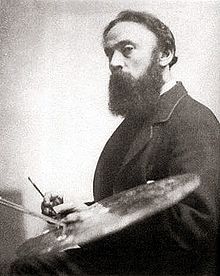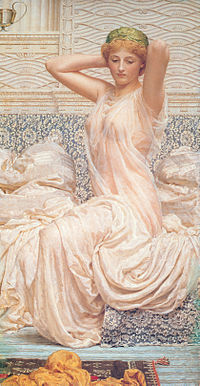- Albert Joseph Moore
-
Albert Joseph Moore 
Albert Joseph Moore, ca. 1870Born 4 September 1841
York, EnglandDied 25 September 1893
London, EnglandNationality British Albert Joseph Moore (4 September 1841 – 25 September 1893) was an English painter, known for his depictions of langorous female figures set against the luxury and decadence of the classical world.
 The Mother of Sisera looked out a Window
The Mother of Sisera looked out a Window
He was born in York in 1841, the youngest of the fourteen children of the artist William Moore of York who in the first half of the 19th century enjoyed a considerable reputation in the North of England as a painter of portraits and landscape.
In his childhood Albert Moore showed an extraordinary love of art, and as he was encouraged in his tastes by his father and brothers, two of whom afterwards became famous as artists — John Collingham Moore and Henry Moore, and he was able to begin the active exercise of his profession at an unusually early age.
His first exhibited works were two drawings which he sent to the Royal Academy in 1857. A year later he became a student in the Royal Academy schools; but after working in them for a few months only he decided that he would be more profitably occupied in independent practice. During the period that extended from 1858 to 1870, though he produced and exhibited many pictures and drawings, he gave up much of his time to decorative work of various kinds, and painted, in 1863, a series of wall decorations at Coombe Abbey, the seat of the Earl of Craven; in 1865 and 1866 some elaborate compositions: The Last Supper and The Feeding of the Five Thousand on the chancel walls of the church of St. Alban's, Rochdale; and in 1868 A Greek Play, an important panel in tempera for the proscenium of the Queen's Theatre in Long Acre.
His first large canvas, Elijah's Sacrifice, was completed during a stay of some five months in Rome at the beginning of 1863, and appeared at the Academy in 1865. A still larger picture, The Shunamite relating the Glories of King Solomon to her Maidens, was exhibited in 1866, and with it two smaller works, Apricots and Pomegranates. In these Albert Moore asserted plainly the particular technical conviction that for the rest of his life governed the whole of his practice, and with them he first took his place definitely among the most original of British painters.
Of his subsequent works the most notable are
- The Quartette (1869),
- Sea Gulls (1871),
- Follow-my-Leader (1873),
- Shells (1874), Topaz (1879),
- Rose Leaves (1880),
- Yellow Marguerites (1881),
- Blossoms (1881),
- Dreamers (1882),
- Reading Aloud (1884),
- Silver (1886),
- Midsummer (1887),
- A River Side (1888),
- A Summer Night (1890),
- Lightning and Light (1892),
- An Idyll (1893), and
- The Loves of the Winds and the Seasons, a large picture which was finished only a few days before his death.
He died in 1893, at his studio in Spenser Street, Westminster.
Several of his pictures are now in public collections; among the chief are Blossoms, in the National Gallery of British Art; A Summer Night in the Liverpool Corporation Gallery; Dreamers in the Birmingham Corporation Gallery; and a water-color, The Open Book, in the Victoria and Albert Museum, South Kensington.
In all his pictures, save two or three produced in his later boyhood, he avoided any approach to story-telling, and occupied himself exclusively with decorative arrangements of lines and color masses. The spirit of his art is essentially classic, and his work shows plainly that he was deeply influenced by study of antique sculpture; but he was not in any sense an archaeological painter, nor did he attempt reconstructions of the life of past centuries. Artistically he lived in a world of his own creation, a place peopled with robust types of humanity of Greek mould, and gay with bright-colored draperies and brilliant-hued flowers. As an executant he was careful and certain; he drew finely, and his color-sense was remarkable for its refinement and subtle appreciation. Few men have equalled him as a painter of draperies, and still fewer have approached his ability in the application of decorative principles to pictorial art.
References
 This article incorporates text from a publication now in the public domain: Chisholm, Hugh, ed (1911). "Albert Joseph Moore". Encyclopædia Britannica (11th ed.). Cambridge University Press. http://www.1911encyclopedia.org/Albert_Joseph_Moore.
This article incorporates text from a publication now in the public domain: Chisholm, Hugh, ed (1911). "Albert Joseph Moore". Encyclopædia Britannica (11th ed.). Cambridge University Press. http://www.1911encyclopedia.org/Albert_Joseph_Moore.
External links
- A J Moore online (ArtCyclopedia)
- A J Moore - biography and works (Art Renewal Center)
- Biography (Victorian Web)
Categories:- 1841 births
- 1893 deaths
- People from York
- English painters
- Academic art
- People educated at Archbishop Holgate's School
Wikimedia Foundation. 2010.

